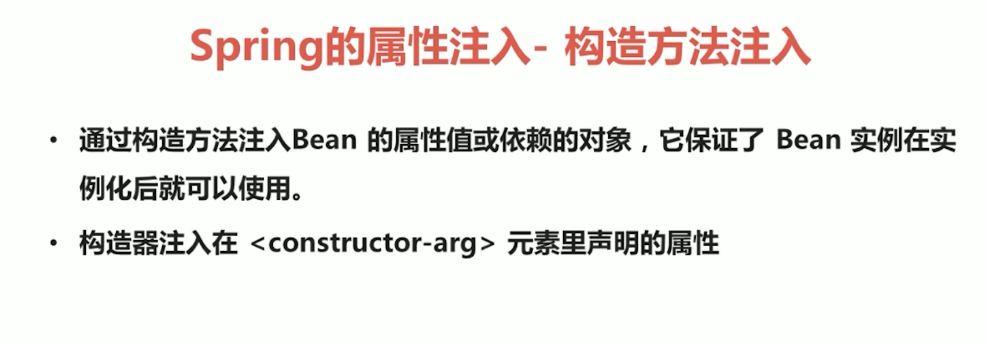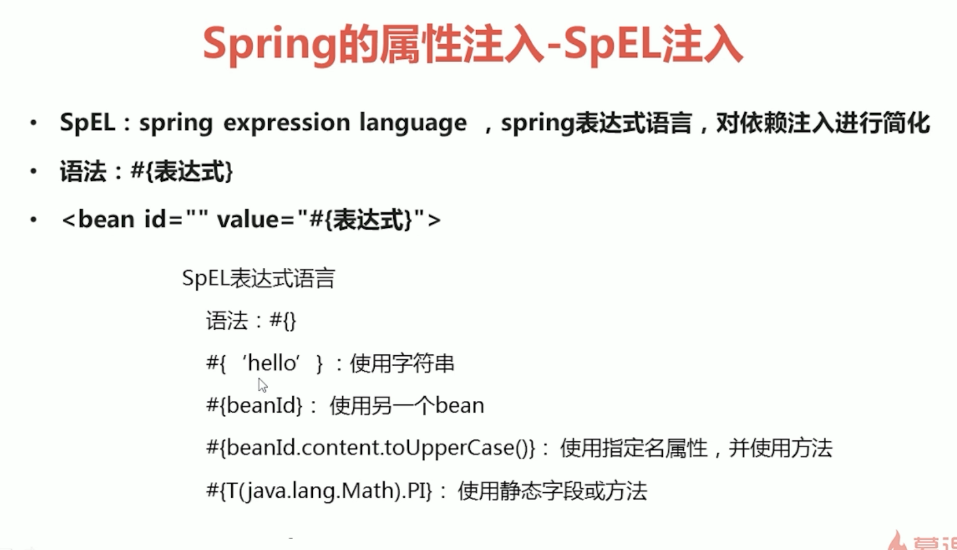spring学习笔记之---bean属性注入
bean属性注入

(一)构造方法的属性注入

1.Student.java
package entity;
public class Student {
private String name;
private String age;
public Student(String name, String age) {
this.name = name;
this.age = age;
}
@Override
public String toString() {
return "Student{" +
"name='" + name + '\'' +
", age='" + age + '\'' +
'}';
}
}
2.applicationContext.xml
<?xml version="1.0" encoding="UTF-8"?>
<beans xmlns="http://www.springframework.org/schema/beans"
xmlns:xsi="http://www.w3.org/2001/XMLSchema-instance"
xsi:schemaLocation="http://www.springframework.org/schema/beans http://www.springframework.org/schema/beans/spring-beans.xsd">
<bean id="student" class="entity.Student">
<constructor-arg name="name" value="李四"/>
<constructor-arg name="age" value="21"/>
</bean>
</beans>
3.StudentTest.java
package Test;
import entity.Student;
import entity.User;
import org.junit.Test;
import org.springframework.context.ApplicationContext;
import org.springframework.context.support.ClassPathXmlApplicationContext;
public class StudentTest {
@Test
public void stu(){
ApplicationContext applicationContext=new ClassPathXmlApplicationContext("applicationContext.xml");
Student student=(Student)applicationContext.getBean("student");
System.out.println(student);
}
}
(二)set方法的属性注入
1.Student.java
package entity;
public class Student {
private String name;
private String age;
public String getName() {
return name;
}
public void setName(String name) {
this.name = name;
}
public String getAge() {
return age;
}
public void setAge(String age) {
this.age = age;
}
@Override
public String toString() {
return "Student{" +
"name='" + name + '\'' +
", age='" + age + '\'' +
'}';
}
}
2.applicationContext.xml
<?xml version="1.0" encoding="UTF-8"?>
<beans xmlns="http://www.springframework.org/schema/beans"
xmlns:xsi="http://www.w3.org/2001/XMLSchema-instance"
xsi:schemaLocation="http://www.springframework.org/schema/beans http://www.springframework.org/schema/beans/spring-beans.xsd">
<bean id="student2" class="entity.Student">
<property name="name" value="张三"/>
<property name="age" value="22"/>
</bean>
</beans>
3.StudentTest.java
package Test;
import entity.Student;
import entity.User;
import org.junit.Test;
import org.springframework.context.ApplicationContext;
import org.springframework.context.support.ClassPathXmlApplicationContext;
public class StudentTest {
@Test
public void stu2(){
ApplicationContext applicationContext=new ClassPathXmlApplicationContext("applicationContext.xml");
Student student2=(Student)applicationContext.getBean("student2");
System.out.println(student2);
}
}
(三)p名称空间的属性注入

1.Student.java
package entity;
public class Student {
private String name;
private String age;
private Cat cat;
public String getName() {
return name;
}
public void setName(String name) {
this.name = name;
}
public String getAge() {
return age;
}
public void setAge(String age) {
this.age = age;
}
public Cat getCat() {
return cat;
}
public void setCat(Cat cat) {
this.cat = cat;
}
@Override
public String toString() {
return "Student{" +
"name='" + name + '\'' +
", age='" + age + '\'' +
", cat=" + cat +
'}';
}
}
2.Cat.java
package entity;
public class Cat {
private String name;
public String getName() {
return name;
}
public void setName(String name) {
this.name = name;
}
@Override
public String toString() {
return "Cat{" +
"name='" + name + '\'' +
'}';
}
}
3.applicationContext.xml
<?xml version="1.0" encoding="UTF-8"?>
<beans xmlns="http://www.springframework.org/schema/beans"
xmlns:p="http://www.springframework.org/schema/p"
xmlns:xsi="http://www.w3.org/2001/XMLSchema-instance"
xsi:schemaLocation="http://www.springframework.org/schema/beans http://www.springframework.org/schema/beans/spring-beans.xsd">
<bean id="student3" class="entity.Student" p:name="小明" p:age="15" p:cat-ref="cat"/>
<bean id="cat" class="entity.Cat" p:name="小黄"/>
</beans>
4.StudentTest.java
package Test;
import entity.Student;
import entity.User;
import org.junit.Test;
import org.springframework.context.ApplicationContext;
import org.springframework.context.support.ClassPathXmlApplicationContext;
public class StudentTest {
@Test
public void stu3(){
ApplicationContext applicationContext=new ClassPathXmlApplicationContext("applicationContext.xml");
Student student3=(Student)applicationContext.getBean("student3");
System.out.println(student3);
}
}
(四)spel的属性注入

1.Student.java
package entity;
public class Student {
private String name;
private String age;
private Cat cat;
public String getName() {
return name;
}
public void setName(String name) {
this.name = name;
}
public String getAge() {
return age;
}
public void setAge(String age) {
this.age = age;
}
public Cat getCat() {
return cat;
}
public void setCat(Cat cat) {
this.cat = cat;
}
@Override
public String toString() {
return "Student{" +
"name='" + name + '\'' +
", age='" + age + '\'' +
", cat=" + cat +
'}';
}
}
2.Cat.java
package entity;
public class Cat {
private String name;
public String getName() {
return name;
}
public void setName(String name) {
this.name = name;
}
@Override
public String toString() {
return "Cat{" +
"name='" + name + '\'' +
'}';
}
}
3.applicationContext.xml
<?xml version="1.0" encoding="UTF-8"?>
<beans xmlns="http://www.springframework.org/schema/beans"
xmlns:p="http://www.springframework.org/schema/p"
xmlns:xsi="http://www.w3.org/2001/XMLSchema-instance"
xsi:schemaLocation="http://www.springframework.org/schema/beans http://www.springframework.org/schema/beans/spring-beans.xsd">
<bean id="student4" class="entity.Student">
<property name="name" value="#{'大名'}"/>
<property name="age" value="#{16}"/>
<property name="cat" value="#{cat}"/>
</bean>
<bean id="cat" class="entity.Cat">
<property name="name" value="#{'大黄'}"/>
</bean>
</beans>
4.StudentTest.java
package Test;
import entity.Student;
import entity.User;
import org.junit.Test;
import org.springframework.context.ApplicationContext;
import org.springframework.context.support.ClassPathXmlApplicationContext;
public class StudentTest {
@Test
public void stu4(){
ApplicationContext applicationContext=new ClassPathXmlApplicationContext("applicationContext.xml");
Student student4=(Student)applicationContext.getBean("student4");
System.out.println(student4);
}
}
(五)复杂类型的属性注入

1.Bean.java
package entity;
import java.util.*;
public class Bean {
private String arr[];//数组类型
private List<String > list;//List集合类型
private Set<String> set;//Set集合类型
private Map<String,Integer> map;//Map集合类型
private Properties properties;//属性类型
public String[] getArr() {
return arr;
}
public void setArr(String[] arr) {
this.arr = arr;
}
public List<String> getList() {
return list;
}
public void setList(List<String> list) {
this.list = list;
}
public Set<String> getSet() {
return set;
}
public void setSet(Set<String> set) {
this.set = set;
}
public Map<String, Integer> getMap() {
return map;
}
public void setMap(Map<String, Integer> map) {
this.map = map;
}
public Properties getProperties() {
return properties;
}
public void setProperties(Properties properties) {
this.properties = properties;
}
@Override
public String toString() {
return "Bean{" +
"arr=" + Arrays.toString(arr) +
", list=" + list +
", set=" + set +
", map=" + map +
", properties=" + properties +
'}';
}
}
2.applicationContext.xml
<?xml version="1.0" encoding="UTF-8"?>
<beans xmlns="http://www.springframework.org/schema/beans"
xmlns:p="http://www.springframework.org/schema/p"
xmlns:xsi="http://www.w3.org/2001/XMLSchema-instance"
xsi:schemaLocation="http://www.springframework.org/schema/beans http://www.springframework.org/schema/beans/spring-beans.xsd">
<bean id="bean" class="entity.Bean">
<!--数组类型-->
<property name="arr">
<list >
<value>aaa</value>
<value>bbb</value>
<value>ccc</value>
</list>
</property>
<!--List集合类型-->
<property name="list">
<list>
<value>111</value>
<value>222</value>
<value>333</value>
</list>
</property>
<!--Set集合类型-->
<property name="set">
<set>
<value>aaa</value>
<value>bbb</value>
<value>ccc</value>
</set>
</property>
<!--Map集合类型-->
<property name="map">
<map>
<entry key="aaa" value="111"/>
<entry key="bbb" value="222"/>
<entry key="ccc" value="333"/>
</map>
</property>
<!--属性类型-->
<property name="properties">
<props>
<prop key="username">111</prop>
<prop key="password">222</prop>
</props>
</property>
</bean>
</beans>
3.BeanTest.java
package Test;
import entity.Bean;
import org.junit.Test;
import org.springframework.context.ApplicationContext;
import org.springframework.context.support.ClassPathXmlApplicationContext;
public class BeanTest {
@Test
public void bean(){
ApplicationContext applicationContext=new ClassPathXmlApplicationContext("applicationContext.xml");
Bean bean=(Bean)applicationContext.getBean("bean");
System.out.println(bean);
}
}
spring学习笔记之---bean属性注入的更多相关文章
- Spring学习笔记(3)——Bean的注入方式
依赖注入 依赖注入支持属性注入.构造函数注入.工厂注入. 属性注入: 属性注入即通过setXxx()方法注入Bean的属性值或依赖对象 属性注入要求Bean提供一个默认的构造函数(无参构造函数),并为 ...
- Spring学习笔记—装配Bean
在Spring中,对象无需自己负责查找或创建与其关联的其他对象.相反,容器负责把需要相互协作的对象引用赋予各个对象.创建应用对象之间协作关系的行为通常称为装配(wiring),这也是依赖注入的本质. ...
- spring学习(三)属性注入
用的是IDEA的maven工程,pom.xml文件导包依赖省略 本文主要写set方式注入 (一).一般类型注入 一.写两个实体类Car.User public class Car { private ...
- spring学习笔记之---bean管理的注解方式
bean管理的注解方式 (一)使用注解定义bean (1)常用注解 (2)实例 1.在pom.xml中进行配置 <dependencies> <dependency> < ...
- Spring学习笔记之Bean的一些属性设置
1.beans 里边配置default-init-method="shunge",有这个方法的会执行,没有也不会报错 2.beans 里边配置default-destroy-met ...
- Spring学习笔记(2)——Bean的配置
要使应用程序中的Spring容器成功启动,需要以下三个方面的条件都具备: 1.Spring框架的类包都已经放到应用程序的类路径下 2.应用程序为Spring提供完备的Bean配置信息 3.Bean的类 ...
- Spring学习笔记之bean配置
1.命名bean 每个bean都有一个或者多个的的标识符.这些标识符必须在加载他们的容器里边唯一.一个bean经常有且只有一个标识符,但是如果需要超过一个的名字,可以考虑额外的别名. 基于xml的配置 ...
- Spring学习笔记之Bean的实例化
一.bean的实例化方法有3种, 1.构造器实例化 2.静态工厂方法实例化 3.实例工厂方法实例化 二.用构造器来实例化 <bean id="ShunDao" class=& ...
- Spring学习笔记——02 Bean的命名及实例化
一.Bean的命名 前一篇讲到IoC是一个管理Bean的容器,Bean多数情况下都是通过XML文件进行配置的,其中Bean的命名有以下几种方式,现在梳理一下. 1. 不指定id,只配置类名 <b ...
随机推荐
- 安装mysql apache php smb
1 SMB LinuX下SMB的配置 使用Smb进行连接的命令: smbclient //192.168.128.1/Share 今天要在LINUX之间以及LINUX与WINDOWS之间互相传送文件, ...
- 大白话五种IO模型
目录 一.I/O模型介绍 二.阻塞I/O模型 2.1 一个简单的解决方案 2.2 该方案的问题 2.3 改进方案 2.4 改进后方案的问题 三.非阻塞I/O模型 3.1 非阻塞I/O实例 四.多路复用 ...
- 时间段(今天,昨天,本周,上周,本月,上月,总)的查询,时间处理函数strtotime
需求:最近get了一个很好用的PHP关于时间的函数strtotime,因为最近有个项目涉及到很多时间段(今天,昨天,本周,上周,本月,上月,总)的查询,要根据指定时间算出它每个范围的开始时间和结束时间 ...
- 并发编程-concurrent指南-阻塞队列-优先级的阻塞队列PriorityBlockingQueue
PriorityBlockingQueue是一个支持优先级的无界阻塞队列. 它使用了和类 java.util.PriorityQueue 一样的排序规则.你无法向这个队列中插入 null 值. 所有插 ...
- 源码阅读 - java.util.concurrent (一)
java.util.concurrent这个包大致可以分为五个部分: Aomic数据类型 这部分都被放在java.util.concurrent.atomic这个包里面,实现了原子化操作的数据类型,包 ...
- kubeadm安装k8s
软件版本: kubelet:V1.13.3 docker: 18.06.1 实验环境: Centos 7.5.1804 说明: 初学.安装步骤参考了阿良的文档,并做了部分修改. 步骤如下: 1.关闭防 ...
- redis 命令的调用过程
参考文献: Redis 是如何处理命令的(客户端) 我是如何通过添加一条命令学习redis源码的 从零开始写redis客户端(deerlet-redis-client)之路--第一个纠结很久的问题,r ...
- C++学习书籍推荐《More Effective C++》下载
百度云及其他网盘下载地址:点我 编辑推荐 <More Effective C++:35个改善编程与设计的有效方法(中文版)>:传世经典书丛 媒体推荐 <Effective c++&g ...
- C# Linq 笛卡尔积
using System; using System.Collections.Generic; using System.Linq; using System.Text; using System.T ...
- 番外:深浅copy
进击のpython 深浅copy copy是什么意思? 复制 (又学一个单词!开不开森) 那啥叫复制呢? 百度百科上给的解释是:仿原样品制造 我们曾经有过这样的印象 a = "zhangsa ...
